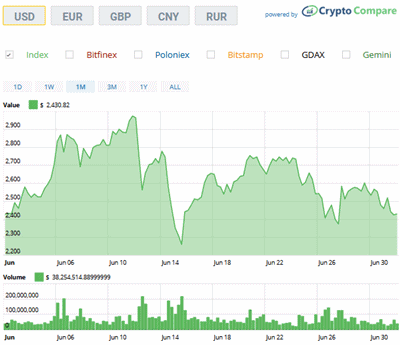My Google news alerts for bitcoin for the 30 days of June included seven days with the mention of 'bubble'. This compares to five days in May, zero days in April, three days in March, and scattered single references since I started tracking the keyword 'bitcoin' two years ago.
- 2017-06-06: Bitcoin is a 'bubble,' Mark Cuban says (businessinsider.com) • 'When everyone is bragging about how easy they are making money, it's a bubble.'
- 2017-06-09: Is bitcoin in a bubble? This metric suggests there’s more room to grow (marketwatch.com) • 'Bitcoin’s "P/E ratio" looks at the digital currency’s network value -- the number of outstanding bitcoins multiplied by price; this figure is currently $44.69 billion -- against its daily transaction volume.'
- 2017-06-10: Four Reasons Bitcoin is Not A Bubble: Analyst (cointelegraph.com) • 'Decentralization, Supply, Security, Fraud-proof'
Astute analysis or wishful thinking? Probably a bit of both. The next article makes no sense at all. (e.g. 'The main factor that makes a digital bubble impossible is market bipolarity.')
- 2017-06-17: There Will Be No Bubble for Bitcoin and Ethereum, Here’s Why. (cointelegraph.com) • 'Such a thing is impossible due to the market-influencing capabilities of Bitcoin and Ethereum.'
- 2017-06-22: The Bitcoin Bubble Will Turn Into Mania Before It Bursts (forbes.com)
- 2017-06-28: Ignore the Naysayers, there’s no Bubble in Bitcoin (newsbtc.com)
On the path from curiosity to bubble to mania, when does the phenomenon become a 'gold rush'?
- 2017-06-23: It's a gold-rush mentality in bitcoins, and many are at risk of losing big (indiatimes.com)
- 2017-06-27: Bitcoin Development Similar to 1800s Gold Rush: Expert (cointelegraph.com)
Here are two more signs of a bubble, impossible or not. Both stories are from mainstream financial news.
- 2017-06-02: Bitcoin start-up Coinbase aims for $1 billion valuation (cnbc.com)
- 2017-06-23: Bitcoin speculators are the new day traders (cnbc.com)
There's nothing about bubbles in the last two stories, but both are worth noting.
- 2017-06-19: Move Over, Bitcoin. Ether Is the Digital Currency of the Moment (nytimes.com) • Nathaniel Popper; chart comparing market caps
- 2017-06-23: itcoin: Why The 'Flippening' Failed - Winklevoss Bitcoin Trust ETF (Pending : COIN) (seekingalpha.com) • 'Many feel that as soon as Bitcoin is dethroned ... dubbed "The Flippening"'
The word 'flippening' was new to me.
